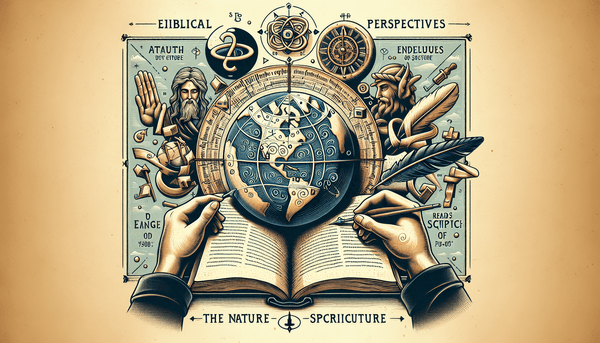The Shape of the Earth and the Bible
Despite some interpreting the Bible as portraying a flat Earth, it is crucial to understand that such interpretations do not hold up against careful scriptural and historical analysis. Isaiah 40:22, for example, refers to God sitting 'enthroned above the circle of the earth,' which should not be hastily taken as an endorsement of a flat Earth. The original Hebrew word for 'circle' can also mean 'sphere' or 'vault,' suggesting a more complex cosmology. In fact, other verses such as Job 26:7, where it states 'He hangs the earth on nothing,' and Proverbs 8:27, which speaks of God drawing 'a circle on the face of the deep,' support a more spherical understanding of the Earth. Moreover, Psalm 104:5 and Job 26:10 further illustrate a dynamic and majestic creation, far from a simplistic flat model. It is evident that the Bible's language is rich with metaphor and requires a nuanced reading that appreciates the symbolism and poetic devices of ancient Hebrew literature.
The Jewish Heritage of Jesus and the Christian Faith
Understanding Jesus' identity is not complete without recognizing His Jewish heritage and the Judaic roots of Christianity. Jesus was born into a Jewish family, as the genealogy in Matthew 1:1 indicates, tracing His lineage back to David and Abraham. His life was steeped in Jewish tradition and law, as evidenced by His participation in festivals like the Passover (Luke 2:41-42). The early Christian community emerged from this Jewish context, with the apostles spreading Jesus' teachings to Jews and Gentiles alike. The Council of Jerusalem, as noted in Acts 15:9, marks a significant moment in the history of the Church, where it was affirmed that God does not discriminate between Jewish and Gentile followers. This inclusivity is a testament to the faith's roots and the universality of its message. Further reflection on the interconnected themes of faith and eternity, as explored in Mark 14 and beyond, provides a profound reflection on the interwoven destinies of Jews and Gentiles within the tapestry of salvation history.
Reading the Bible: Approaches and Context
Approaching the Bible can be a daunting task, but there are recommended strategies that can aid in its understanding. Beginning with the New Testament, particularly the Gospels, provides direct insight into the life and teachings of Jesus. This foundation allows for a richer comprehension of the Old Testament, which sets the stage for the New. Spiritual guidance through prayer and reflection is invaluable when interpreting scripture, as it opens the heart to deeper meanings and connections. The Bible is not merely a historical document but a living text that continues to speak to believers today. It encourages a journey of continual learning and discovery, inviting readers to engage with its truths and find their own place within its sacred narrative.
FAQ
Q: Does the Bible say the Earth is flat?
A: No, the Bible does not explicitly state that the Earth is flat. While some verses have been interpreted to suggest a flat Earth, scholars often view these as metaphorical or symbolic. For example, Isaiah 40:22's reference to 'the circle of the earth' is better understood in the context of ancient Hebrew language, which can imply a spherical shape.
Q: Is the world flat?
A: Scientific evidence and observations confirm that the Earth is an oblate spheroid, not flat. It is mostly spherical, with a slight flattening at the poles and a bulging at the equator.
Q: Is Jesus God Himself or His son?
A: According to the doctrine of the Trinity in Christianity, Jesus is both the Son of God and divine. He is one with God the Father and the Holy Spirit, as expressed in scriptures like John 10:30 and John 1:1.
Q: What is the best order to read the Bible in?
A: While there is no one 'best' way to read the Bible, a common recommendation is to start with the New Testament, particularly the Gospels, to learn about the life and teachings of Jesus before moving on to the Old Testament for broader context.






